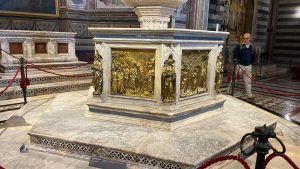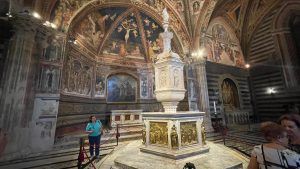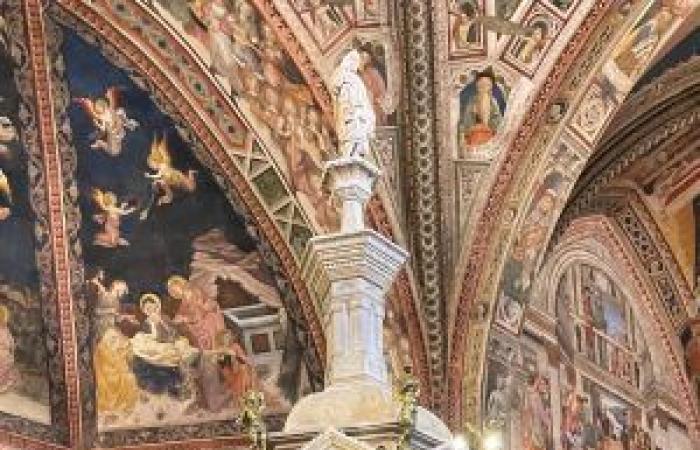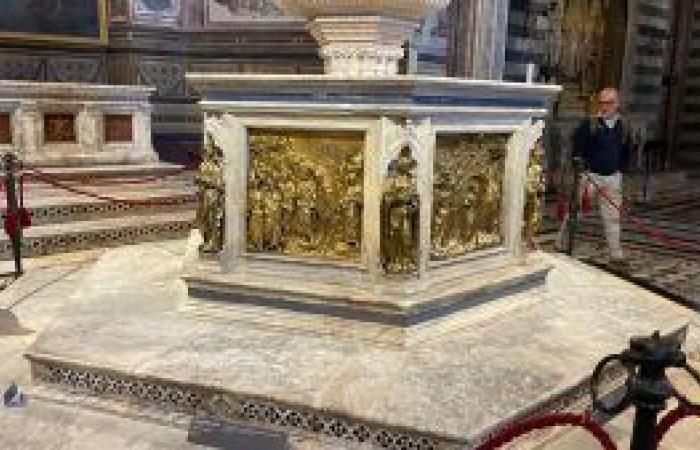The Siena Metropolitan Opera and the Archdiocese of Siena, Colle di Val d’Elsa and Montalcino presented the restoration works that return the baptismal font of the Siena Cathedral to the community. In fact, from 25 June – after three years of conservative interventions – the extraordinary sculptural structure created by Donatello, Jacopo della Quercia, Ghiberti and Giovanni di Turino will be visible again.
The restoration is the result of a series of interventions, of a very high and innovative technical level, conducted by the staff of the Opera and the highly specialized staff of the Opificio delle Pietre Dure, led first by the late Marco Ciatti and subsequently by Emanuela Daffra. Under the high surveillance of the officials of the Superintendency of Archaeology, Fine Arts and Landscape for the provinces of Siena, Grosseto and Arezzo, first directed by Andrea Muzzi and, currently, by Gabriele Nannetti, the staff of the Opera and the Opificio, with the fruitful collaboration of restorers and university professors, took turns in the complex restoration of a work resulting from the brilliant expertise of the greatest artists of the first half of the fifteenth century: different but connected interventions which, once completed, return to the Church, the City and the world , a central place from a pastoral and liturgical point of view and, at the same time, a true masterpiece of immeasurable beauty.

“For a Christian, a new life is born with baptism – underlines Cardinal Augusto Paolo Lojudice, archbishop of Siena – Colle di Val d’Elsa – Montalcino – and the baptismal font of the Siena cathedral has seen many ‘born to a new life’ generations of famous and less famous Sienese, many ordinary people, all inextricably linked to this unique city. Today, the strong spiritual and religious connotation is added to the suggestion for the restitution to the world of an absolute masterpiece of the Italian Renaissance”.
“The entire cathedral complex of our city – adds card. Lojudice – is a treasure chest that contains immense masterpieces of art that find their inspiration in the Christian tradition which in Siena and its territories has been able to transform itself into the keystone of the communities”
The restoration intervention, financed by the Siena Metropolitan Opera, is the result of a real and concrete synergy between the Fabbriceria, the Superintendency of Archaeology, Fine Arts and Landscape for the provinces of Siena, Grosseto and Arezzo and the Opificio delle Pietre Dure of Florence (OPD), which was entrusted with the direction of the restoration, coordinated by art historians Laura Speranza and Riccardo Gennaioli, respectively directors of the Bronze Restoration and Stone Materials sectors of the OPD. The employees of the Opera del Duomo and, in particular, all the employees of the Technical Area, with the help of those of the Security Area and the other Areas, actively participated, each according to their own skills, in the necessary conservation activities including those of stone restoration which were directly carried out by the Institution’s staff: by the Restorer Andrea Galgani, and by the restoration collaborators Serena Bianchi and Lucrezia Coletta who, on a daily basis, together with the external restorer Irene Giovacchini, carried out consolidation and cleaning interventions following the indications and methodological choices developed by the technical and scientific direction of the restoration entrusted to the Stone Materials Restoration sector of the OPD with the restorer Camilla Mancini, personally active, and Riccardo Gennaioli, director of the sector.
In the OPD laboratories in Florence, the internal restorers Maria Baruffetti, Annalena Brini and Elisa Pucci from the Bronzes sector directed by Laura Speranza worked on the metal parts, under the technical direction of Stefania Agnoletti. External restorers were also involved (Antonio Mignemi, Stefano Casu, Elena dellaSchiava and Merj Nesi).
The scientific investigations were conducted by OPD (Andrea Cagnini, Monica Galeotti, Simone Porcinai) and by a large group of external professionals. A structured team, therefore, which was able to operate in close synergy. The technical area of the Opera del Duomo directed by the architect Enrico De Benedetti also designed and managed the new layout of the Baptistery aimed at improving its reception and use.

“Maintain, conserve, restore and enhance the assets entrusted to us. These are some of the institutional tasks of the Opera della Meropolitana di Sioni states the Rector prof.
Giovanni Minnucci – “and, by will of the Board of Directors whom I sincerely thank, we have rigorously adhered to them even on this very happy occasion. Giving back, admirably restored – to the Church, to the City of Siena, and to the many people who visit the monumental complex – an asset of enchanting and unparalleled beauty, such as the baptismal font, was a mission to which we willingly dedicated ourselves, together to all the staff of the Opera, that of the Opificio delle Pietre Dure, the university professors and the technicians external to the two institutions. We were fully aware, also in light of the decisions taken by the previous CA, not only of the unavoidable need to proceed with restoration operations that had never occurred, but also deeply convinced of the results that the synergy between the many subjects involved, thanks to their respective specific skills, could have generated. We are therefore grateful to all those who, in various capacities, have undertaken this undertaking which unquestionably contributes to the conservation of a very precious liturgical and artistic asset: an asset whose vision, from now on – we are certain – will arouse strong emotions and the convinced appreciation of all those who, coming to visit, stop inside the Baptistery to admire it”.
Positioned at the center of the architectural structure of the Baptistery, the baptismal font is one of the major masterpieces preserved within the monumental complex of the Siena Cathedral. Extraordinary work in marble, bronze and enamelled copper created between 1417 and 1431 by the most important sculptors of the early Renaissance. The Source consists of a hexagonal basin in which are inserted the six gilded bronze mirrors depicting the life of the Baptist, punctuated by the statues of virtue, two of which, Faith and Hope, created by Donatello. Among the most representative episodes, the Baptism of Jesus by Lorenzo Ghiberti of 1427 takes on particular importance, an elegant and refined scene characterized by pictorialism and a sense of depth obtained thanks to a gradual reduction of the relief. The cycle ends with the famous Banquet of Herod by Donatello, the most touching scene due to the drama of the subject and the formal qualities. The importance of the Font – as a focal point in the definition of the principles of the Renaissance – the complexity of the conservation interventions for the gilded bronze works and the marble elements required very careful investigations and great skills in defining the restoration program.
“Dealing with such a complex and significant work for the history of art is always difficult – says Emanuela Daffra, Superintendent of the OPD – In this case the difficulties were, are, increased by other factors: on the one hand the use value of the Font, born as an ‘instrument’ for the administration of a sacrament, which this function still maintains. On the other hand, environmental conditions that are not ideal for conservation, especially of the bronzes. The OPD staff has taken up the challenge of maintaining the monument for now both in its completeness and its original purpose, but this is precisely where the program of six-monthly inspections and the invitation to monitor and carefully control the environmental parameters comes from. Only constant attention will allow us to promptly detect signs of degradation and immediately identify the most suitable measures”.
A famous work, the Fonte combines marble, once enriched with blue and gold polychrome details, and gilded bronzes. The architectural structure is entirely made of white marble of two different qualities: for the lower register a veined variety coming from the Sienese Montagnola, for the tabernacle and the figure of the Baptist a second, much more homogeneous variety quarried in the Apuan area.
The bronze (copper alloy) parts show a gilding with an amalgam of gold and mercury (the so-called “fire gilding”). The gold was tarnished, the surfaces were affected by abrasions and the state of conservation of the stone material was also rather uneven, much worse in the lower register than in the upper part.
To verify the statics of the architectural structure and the environmental parameters, two different in situ investigation campaigns were undertaken: ultrasonic measurements verified the presence of metal anchors inside the Source and geophysical investigations on the floor investigated the presence of voids or humidity fronts in the substrate archaeological.
An in-depth diagnostic campaign preceded and accompanied the entire intervention with the first phases involving the dismantling of the bronze elements to adequately evaluate the state of conservation of the non-visible surfaces and intervene on areas with significant alterations, which otherwise would not have been accessible.
Thanks to the intervention it was possible to observe the creations of Giovanni di Turino (Birth of the Baptist panel, Predica del Battista panel and Virtù Prudenza panel) which proved to be the result of an ingenious assembly of portions cast separately.
The careful study of Donatello’s panel Banchetto di Erode has made it possible to identify the presence, in the past, of tie rods applied between the arches above the scene which must have amplified the perspective and realistic effect of the architecture depicted which offers three different spaces in succession.
The stone elements were restored on site in the construction site set up inside the Baptistery. If the disassembly was not simple, the reassembly was no different, as it involved the study and creation of new elements and fixing joints made specifically in order to readjust the positions of the incorrect stone architectural elements. The state of conservation and the need to make the non-visible parts of the tiles accessible for inspection over time has dictated the design of a support structure for the stone elements which allows access to the back of the bronzes without necessarily having to dismantle the blocks. marble.
A complex and long job, therefore, but which responsibly took into account, as far as possible, the needs of use: the various bronze parts, once restored, were returned to Siena so that the Opera della Metropolitana could display them in the windows arranged on the sides of the scaffolding erected around the Source and offer them to visitors. A panel and two statues of Virtue (Faith and Hope) were exhibited at the Florentine Donatello exhibition. The Renaissance, curated by Francesco Caglioti in Palazzo Strozzi (19 March-31 July 2022).
In the future, environmental monitoring and the adoption of humidity control systems will be necessary to ensure the best conservation of this masterpiece.








